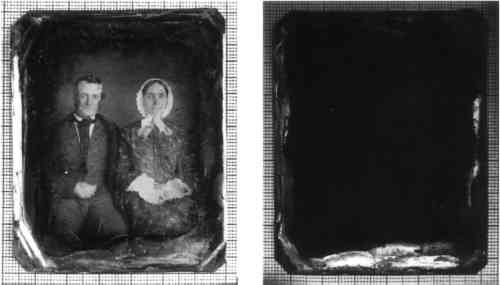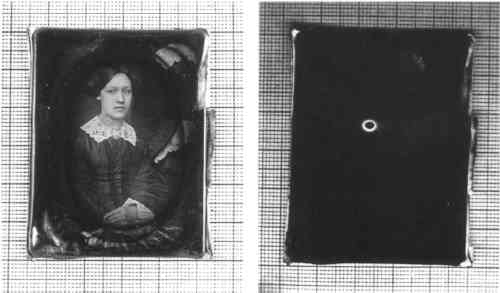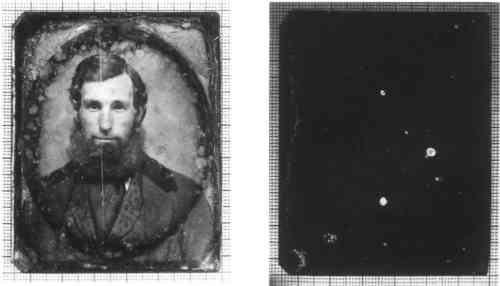INVESTIGATION OF A SURFACE TARNISH FOUND ON 19TH-CENTURY DAGUERREOTYPESLEE ANN DAFFNER, DAN KUSHEL, & JOHN M. MESSINGER
3 DESCRIPTION OF THE FLUORESCING TARNISHA long-wave ultraviolet lamp can be used to accentuate surface anomalies on daguerreotypes, such as scratches and applied color, as observed at the Eastman House. The reflection of visible blue light that leaks through the long-wave lamp's filter seems to help highlight subtle variations in the surface. Long-wave illumination does not reveal more information about the plate's condition with respect to observed fluorescence, however, because the daguerreotype plates do not emit visible fluorescence. On the other hand, using short-wave ultraviolet illumination, a spectacular fluorescence can be seen on some daguerreotype plates (fig. 1).
Because glass absorbs short-wave ultraviolet radiation, bound, encased daguerreotypes cannot be examined with short-wave ultraviolet illumination. A rehousing and photo-documentation project such as the one at the Strong Museum thus provides an ideal opportunity to survey and record this phenomenon. The 79 daguerreotypes examined at the Strong Museum are part of the Walter Johnson Collection of postmortem and mourning-related objects. The Johnson daguerreotypes are the single largest known collection of postmortem daguerreotype portraits in the United States. The collection, assembled over a 20-year period by Johnson, focuses on the postmortem portrait most commonly encountered in the 19th century. It also includes 19th- and 20th-century examples of memorial cards, lithographic prints, mourning jewelry, advertisements, and literature from Johnson's reference library. Only 15 of the daguerreotypes surveyed had older or original seals. Twenty-one were sealed with modern tapes, including masking tape and clear, pressure-sensitive tapes. The remaining daguerreotypes were not sealed at all, although evidence of previous tapes was observed on the verso of these plates. Seventy plates in the Johnson Collection showed signs of some previous cleaning attempts. Overall the collection was in fair to good condition, considering the degree of handling, unbinding, and rebinding of the plates and cleaning that had been undertaken (Daffner 1992). Twenty-one daguerreotypes in private collections and 10 French daguerreotypes from the George Eastman House were also examined, bringing the total to 110 plates. Of these 110, 50% exhibited the fluorescing tarnish. The fluorescence appears to occur primarily in three forms, although many variations were observed. 3.1 EDGE TARNISHThe fluorescence is most commonly present at the very edge of the plate, although under normal illumination it is not always possible to discern the exact location of the fluorescing region. The presence of the fluorescence at the edge of the plates may correspond to those areas that were not completely toned or gilded during the final processing procedures (fig. 2).
At the height of the daguerreotype's popularity, the process of gilding the daguerreotype image was a regular procedure. The most common technique used by operators was to hold the plate, image side up, parallel to the table, over an alcohol lamp. A solution of gold chloride was poured onto the image side of the plate and contained there by surface tension. When the gilding was complete, excess solution could be poured off at one corner. Except at the point of pouring off, the very edges were often not completely covered with the gold chloride solution. In our study, fluorescence was observed to be associated with these nongilded edges, which were often tarnished. 3.2 RINGSThe fluorescence also appears as rings. There can be a single ring or several concentric rings present at a single location (figs. 3, 4). These rings are sometimes visible under normal illumination as a very light orange stain. Small accretions at the nucleus of rings were occasionally observed.
3.3 CONTINUOUS FILMSIn several examples, the fluorescence was also observed as a continuous film. In these instances, it was not always possible to see the location of the fluorescence under normal light (see fig. 1). 3.4 OPENING OF METAL MATThe fluorescence was observed in some plates to be present only within the opening of the decorative metal mat (fig. 5). The cover glass, however, does not appear to have a direct effect on the development of the fluorescence, as on other plates the tarnish was found underneath metallic mats where there was no contact between the cover glass and the daguerreotype plate.
The following additional observations were made: On some plates, the fluorescence is related to pits, scratches, or losses in the surface silver. Fluorescence was seen to be associated with the addition of gold flake coloring, primarily occurring directly adjacent to the area of application. Ninety American daguerreotypes were examined, of which 47 showed fluorescence. Ten French daguerreotypes from the George Eastman House were also examined. The fluorescence was observed on three of these plates. On two plates examined, the fluorescence was observed alongside unidentified fibrous accretions. The variety of patterns and relative degrees of fluorescence observed on the plates suggest a number of causes for the fluorescence. |




